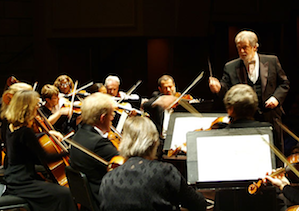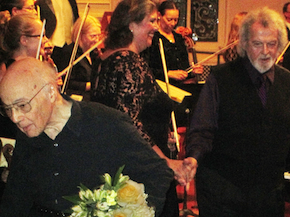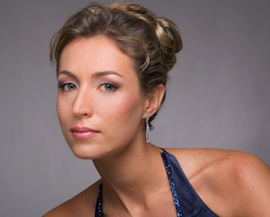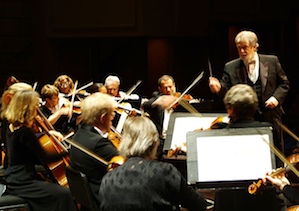
The first impressions Friday night were visual: the beguiling, bright interior of St. Mark's Lutheran Church with the setting sun streaming through the stained glass windows that make up the entire side walls, and the size of orchestra and chorus, some 50 musicians filling the chancel, between the altar and the nave.
Next came the aural experience: the church's fine, lively acoustics — only a few echoes bouncing around — and the orchestra's powerful sound.
This is Midsummer Mozart's 40th season — hard to believe, especially for those who were there at the beginning — and Founder/Director/Mozart Maven George Cleve opened the concert with the savagely percussive and brassy "Turkish" blast of the Overture to The Abduction from the Seraglio. The music rocked, with surging energy, a vital pulse not always associated with Mozart, but exactly right in the here and now.
The opera figured prominently in the festival's genesis. Back then, Cleve was preparing to conduct the San Francisco Opera's spring series production of Abduction, and rallied the orchestra musicians around to form the festival.
Even today, Cleve, a renowned Vienna-born Mozart specialist, remembers well the first rehearsal for the festival: “It happened to be my 39th birthday and we were working on Mozart’s Symphony No. 39." Besides working with such veteran stars as pianist Seymour Lipkin, Cleve and Midsummer Mozart have featured a bevy of youngsters, who are on their way or have gone on to important careers: pianist/violinist Audrey Vardanega, singers Rebecca Davis, Kirk Eichelberger, Christopher Bengochea, many others, some right out of Crowden School.

The Midsummer tribe is still sticking together, some of the original members play in the orchestra, Lipkin was the featured soloist this time, Vardanega (now Lipkin's student in New York) in the audience.
The concert quieted down after Abduction, with the Missa Brevis in C Major, K. 220 (Spatzenmesse) — written in the year of the Declaration of Independence in the American colonies, also the beginning of 20-year-old Mozart's revolution against Salzburg Archbishop Colloredo.
The "Brevis" is one of the briefest of masses, running about 17 minutes, including pauses. (The record may be Haydn's Missa Brevis, at 13 minutes.) Performed splendidly by the San Francisco Boys' Chorus, under the baton of Ian Robertson (veteran director of both the Boys' Chorus and the S.F. Opera Chorus), the work seemed too short, the music for four soloists subsumed by the chorus. It was followed by another miniature, the five-minute Laudate Dominum, K. 339.
During the "Sparrow Mass" — so named by somebody who thought violin figures in the Sanctus and Benedictus recalled the chirping of birds — there was display of consummate professionalism by the chorus. When one of the youngest singers in the first row fainted, help rushed to him (he was fine, just momentarily dizzy), but the performance continued unabated.

As if trying to fill time for the brevity of the two selections, the chorus continued with three not entirely thrilling excerpts from The Magic Flute. The "Trio of Spirits" is appropriate enough, the boys' chorus singing the role of three boys from the opera, but "Oh Isis und Osiris" — both Sarastro's aria and the priests' chorus, only the latter performed here — are associated with low voices, not boy sopranos and altos. I wonder about Robertson's encouragement of the audience to applaud after each brief piece. The "Priests' March" concluded the first half.
Moscow-born, Russian- and American-trained mezzo Anna Yelizarova has a powerful, forward-placed, well-projected voice, which made "Parto, parto" from La Clemenza di Tito sound as if sung by Erda emerging from the deep to warn Wotan against the disasters to befall on him and the world. True, Sesto is a manly trouser role, and what he/she sings is "E a vendicarti io volo" ([I] fly to avenge you), but it still sounded more subterranean than semi-helden. Mark Brandenburg's clarinet obligato had a more traditional Mozartean sound.
The program-closing D Minor Concerto, K. 466, is one of Mozart's miracles: instantly accessible (and now wildly popular, used by movie soundtracks and commercials) and yet with untold depths and complexities. Cleve led an exemplary performance, the orchestra playing with precision and beauty of sound that stems from musicians listening to each other.
Lipkin's solo, especially at the beginning, seemed different from what I heard in his masterful playing of the past. The notes were right, of course, the spirit of the music coming through as well. But there was something tentative, almost hesitating at times, with the piano rarely leading the orchestra, and blending in with it. It might have been something deliberate or a sign of the 87-year-old artist's subsiding powers.
However long a record I have of listening to Lipkin, it isn't as long as Robert Commanday, so as long as we were both in the audience, I invited him to have his say:
Lipkin plays as deep into the keyboard and with a technique as good as ever as I have known for the past 62 years of our acquaintance. In the D minor, sensitivity to the intimate and mysterious, querying and wondering facets of the work that stand in such contrast between the work's dark and intense qualities may have given you the impression of [the occasionally tentative sound].
Unlike the usual "I know what I heard," I would prefer if that contrasting opinion were right. Midsummer Mozart's 40th season concluded on Sunday with a performance of this program in Bing Concert Hall, at the invitation of Stanford Live.

